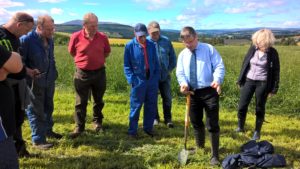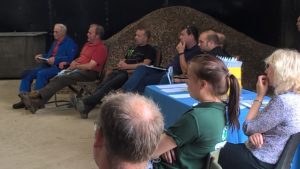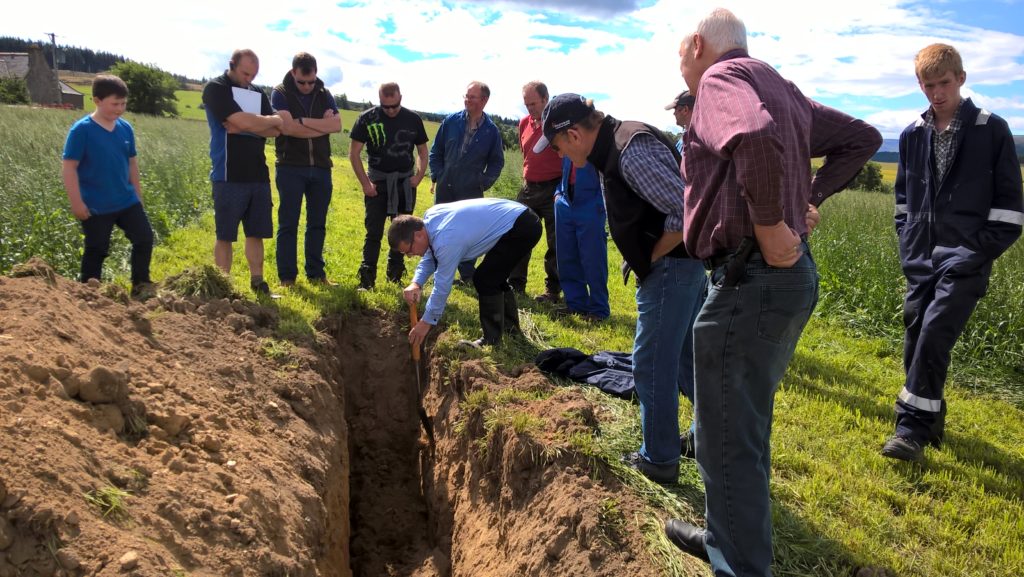Moray Soil & Nutrient Network: 1st meeting event summary
23 July 2018This was the 1st meeting of the Moray Soil & Nutrient Network Farm so it started with an introduction to the farm and the Soil & Nutrient Network.
The first topic for discussion was soil analysis. Aileen Buchanan (SAC Consulting) gave a presentation about why, when and how to sample. Following from this interpretation of the results, with particular focus on soil pH and the main nutrients. You can read Aileen’s presentation slides here.
Soil & drainage expert, Gavin Elrick (SAC Consulting) then led the group with a presentation about soil structure, texture and compaction. This included an outdoor session looking at soil pits in three different fields. These included examples of non-compacted soil, compacted soil caused by livestock and also vehicular traffic. You can read Gavin’s presentation slides here.
 Once a problem in soil structure has been identified, it is important to select the correct piece of machinery to help alleviate the issue. There were working demonstrations in the field of some of the machinery tools available, including a sward lifter, a flat lifter and an aerator.
Once a problem in soil structure has been identified, it is important to select the correct piece of machinery to help alleviate the issue. There were working demonstrations in the field of some of the machinery tools available, including a sward lifter, a flat lifter and an aerator.
This included looking at soil pits in three fields to see examples of no compaction and compaction caused by livestock and vehicle traffic. There was also a demonstration of different machinery that could be used to treat compaction and to see the resultant effect on the soil.
Key messages:
- Soil structure, use spade first to check where and at what depth the problem is before using machine
- Soil must be in the correct condition before remediation is carried out
- Deep subsoiling should be carried out carefully to avoid making the problem worse
- Use gravel filled drains in heavy soil to remove water from sub soiler channels
- Check pH status of soil regularly
- Plan cropping carefully where pH is below optimum
- Allow time (up to 2 years) from lime application to allow lime to be fully active.
Information was available to take away from the event, this and other relevant material can be downloaded from the links below. A collection of photos from the event is available on our Facebook album.
- Moray Soil & Nutrient Network 1st meeting presentation slides used by Aileen Buchanan
- These are the presentation slides used by Aileen Buchanan during the 1st meeting of the Moray Soil & Nutrient Network Farm, giving an overview of the importance of soil testing.
- Topics: Soils
- Moray Soil & Nutrient Network -1st meeting presentation slides used by Gavin Elrick
- These are the slides used by Gavin Elrick during his presentation about "Nutrients, structure & drainage for grass" at the 1st meeting of the Moray Soil & Nutrient Network.
- Topics: Soils
- Valuing Your Soils – Practical Guidance for Scottish Farmers
- This brochure includes useful information about Scotland's agricultural soils and practical advice outlining the upfront financial savings and business benefits of better soil management and the efficient use of resources. Action and problem-specific 'field-sheets' are designed for busy farmers with limited time for reading.
- Topics: Soils, Climate Change, Water Management and Crops and Soils
- Practical Guide: Soil sampling I – How to take a soil sample
- This practical guide details what is required to take a soil sample for analysis that is representative of the area sampled.
- Topics: Soils, Climate Change and Water Management
- Practical Guide: Soil sampling II – Benefits to your business
- This practical guide details how soil sampling can benefit businesses by increasing productivity and create efficiencies on fertiliser inputs through better nutrient planning.
- Topics: Soils, Climate Change and Water Management
- Farming For A Better Climate: Practical Guide – Improving Soil Quality
- This Practical Guide concentrates on how we can improve soil quality to help us to adapt to climate change.
- Topics: Soils
- Practical Guide: Managing Soil Phosphorus
- This Practical Guide will help you manage the phosphorus in your soils. It will help you understand the risk of phosphorus pollution and how you can reduce bagged fertiliser costs in grassland by incorporating nitrogen fixing clover into your sward.
- Topics: Soils, Climate Change and Water Management
- Farming For A Better Climate: Practical Guide – Alleviating Soil Compaction
- This Practical Guide gives some ideas on how to alleviate soil compaction.
- Topics: Soils
- Farming For A Better Climate: Practical Guide – Soil Management
- Topics: Soils
- Practical Guide: Nutrient budgeting I – The Benefits to your Business
- This practical guide looks at the benefits of creating and using a nutrient budget for your farm business.
- Topics: Climate Change
- Practical Guide: Nutrient Budgeting II – Getting Started
- This practical guide looks at what factors you need to consider when making a nutrient budget for your farm, fertiliser recommendations and how to get the most out of your nutrient budget.
- Topics: Climate Change
- Practical Guide: Tyre Selection & Management
- This practical guide explains how to reduce soil damage, improve fuel usage and reduce overall green house gas emissions by selecting the correct tyre size, type and pressure.
- Topics: Climate Change
- Soil Management Practical Guide
- Scottish soils are a valuable store of carbon, particularly the peat soils of the uplands and islands.
- Technical Note (TN656): Soil Information, Texture & Liming Recommendations
- • Web based access to information on your soils on your farm is described. • Soil texture classes of mineral soils are described and identified by hand texturing. • Liming recommendations for different soils and managements are tabulated.
- Topics: Soils
- Technical Note (TN657): Management of Copper in Soils for Cereals
- The soils of Scotland have developed from a range of complex geological parent materials that vary widely in composition. In the relatively young soils over much of the UK, the parent material remains the dominant factor in determining the soil copper status.
- Topics: Soils, Water Management and Crops and Soils
- Technical Note (TN668): Managing Soil Phosphorus
- Efficient soil P management is challenging due to the varying ability of soils to mediate and regulate plant available forms of P. Farmers and land managers in Scotland are now able to access farm level information about their soils making it possible to provide more accurate P management advice.
- Topics: Crops and Soils
- Technical Note (TN664): Management of Cobalt in Grassland Soils
- Topics: Soils
- Technical Note (TN685): Sulphur Recommendations for Crops
- This technical note examines the use of sulphur (S) for crops, and outlines sulphur deficiency, recommendations for use and availability of nutrients in organic fertilisers.
- Visual Evaluation of Soil Structure (VESS) Score Chart
- This is a downloadable copy of the Visual Evaluation of Soil Structure (VESS) score chart for use in-field.
- Topics: Soils
Sign up to the FAS newsletter
Receive updates on news, events and publications from Scotland’s Farm Advisory Service


